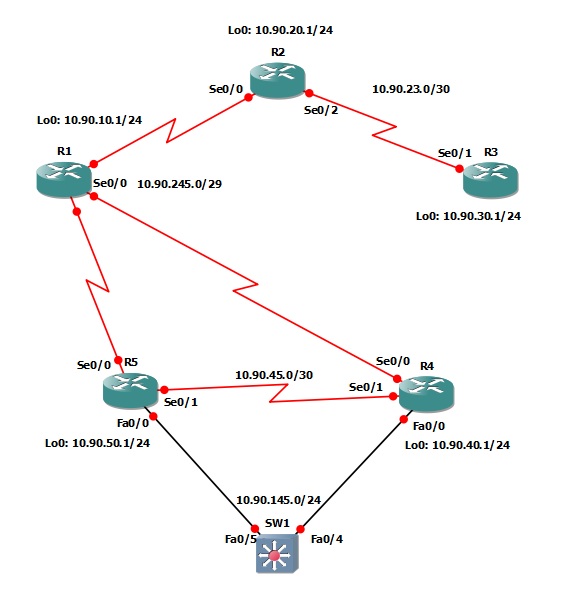Configuring OSPF Default Route Propagation
Advertising a default route into OSPF can be done multiple ways, through the use of redistribution or default information originate. This lab will discuss and demonstrate the configuration and verification of OSPF default route propagation.
Real World Application & Core Knowledge
Configuring OSPF to advertise a default route through out the OSPF domain is very similar configuring the default route propagation in the Routing Information Protocol (RIP) found in Lab 7-7 – Configuring Rip Default Information Originate except there are two differences.
In RIP you use the default-information originate command in RIP router configuration mode and this will advertise a default route through out the RIP domain. However if you issue this command in OSPF router configuration mode this will advertise a default route from the router as a type 5 LSA in a normal area (Non-Backbone/Non Stub Area). This command will not advertise a default route unless a static default route exist on the router you’ve issued this command on.
In order to advertise a default route through out area 0 such as a route to an ISP you can use the default-information originate always in OSPF router configuration mode which will advertises a type 3 0.0.0.0/0 LSA to the entire network or you can redistribute a static default route into the OSPF routing process which will be discussed in Section 10.
In this lab you will configure R1 to advertise a default route to all routers in the OSPF autonomous system.
Familiarize yourself with the following new command(s);
| Command | Description |
|---|---|
| default-information originate | This command is executed in OSPF router configuration mode to advertise the default route as a type 3 Summary LSA to 0.0.0.0/0 only if a default route already exist in the routing table. |
| default-information originate always | This command is executed in OSPF router configuration mode to always advertise the default route as a type 3 Summary LSA to 0.0.0.0/0. |
The following logical topology shown below is used in labs found through out Section 9 – Configuring OSPF;

Lab Prerequisites
- If you are using GNS3 than load the Stub Area Networking GNS3 topology than start devices; R1, R2, R3, R4, R5 and SW1.
- Establish a console session with devices R1, R2, R3, R4, R5 and SW1 than load the initial configurations provided below by copying the config from the textbox and pasting it into the respected routers console.
Lab Objectives
- Configure R1 to always originate a default route through out the entire OSPF autonomous system.
- Verify that the default route is being propagated correctly by viewing the routing table on R4.
Lab Instruction
Objective 1. – Configure R1 to always originate a default route through out the entire OSPF autonomous system.
R1#configure terminal Enter configuration commands, one per line. End with CNTL/Z. R1(config)#router ospf 1 R1(config-router)#default-information originate always R1(config-router)#end R1#
Objective 2. – Verify that the default route is being propagated correctly by viewing the routing table on R4.
R4#show ip route
Codes: C - connected, S - static, R - RIP, M - mobile, B - BGP
D - EIGRP, EX - EIGRP external, O - OSPF, IA - OSPF inter area
N1 - OSPF NSSA external type 1, N2 - OSPF NSSA external type 2
E1 - OSPF external type 1, E2 - OSPF external type 2
* - candidate default, U - per-user static route
o - ODR, P - periodic downloaded static route
Gateway of last resort is 10.90.245.1 to network 0.0.0.0
10.0.0.0/8 is variably subnetted, 15 subnets, 5 masks
O IA 10.90.50.1/32 [110/64767] via 10.90.245.5, 00:54:52, Serial0/0
C 10.90.40.0/24 is directly connected, Loopback0
O IA 10.90.23.0/30 [110/129532] via 10.90.245.2, 00:54:52, Serial0/0
C 10.44.6.0/24 is directly connected, Loopback6
C 10.44.7.0/24 is directly connected, Loopback7
O IA 10.90.30.1/32 [110/129533] via 10.90.245.2, 00:26:12, Serial0/0
C 10.44.4.0/24 is directly connected, Loopback4
O 10.44.4.0/22 is a summary, 00:54:52, Null0
C 10.44.5.0/24 is directly connected, Loopback5
C 10.90.45.2/32 is directly connected, Serial0/1
C 10.90.145.0/24 is directly connected, FastEthernet0/0
C 10.90.45.0/30 is directly connected, Serial0/1
O IA 10.90.20.1/32 [110/64767] via 10.90.245.2, 00:54:53, Serial0/0
O IA 10.90.10.1/32 [110/64767] via 10.90.245.1, 00:54:53, Serial0/0
C 10.90.245.0/29 is directly connected, Serial0/0
O*E2 0.0.0.0/0 [110/1] via 10.90.245.1, 00:00:17, Serial0/0
R4#
